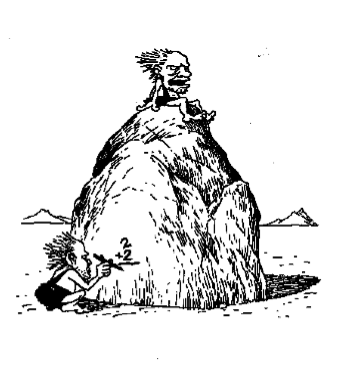(1.1) Because It’s There
(1.1.1) In 1923, the New York Times asked George Mallory why he wanted to climb Everest. He told them,
(1.1.1.1) “Because it’s there.”
No one asked him,
(1.1.1.2) “How do you know it’s there?”
Let alone,
(1.1.1.3) “What, exactly, is it?”
There are certain ontological issues mountain climbers are not called upon to address.
(1.2) Making Infinitely Many Assertions at Once
(1.2.1) Until 1995, the most famous open problem in mathematics was Fermat’s Last Theorem, or, as it ought to have been called, the Fermat Conjecture. The lawyer and number theorist Pierre de Fermat asserted in the seventeenth century that
(1.2.1.1) “There are no positive whole numbers a, b, c, and n, where n is at least three, such that an + bn = cn.”
Fermat jotted down (1.2.1.1) in the margins of his copy of Diophantus’s Arithmetica, with the remark
(1.2.1.2) “I have discovered a truly remarkable proof which this margin is too small to contain.”
It’s worth pausing, first of all, to appreciate what a serious achievement Fermat was claiming. To prove that an equation does have a solution is, in principle, easy business; you just exhibit the solution. But to show an equation has no solution is a different, and deeper, matter—it requires you to prove infinitely many assertions at once.
(1.2.1.1) says that for every one of the infinitely many choices of a, b, c, and n, the equation an + bn = cn does not hold. Such a statement can never be checked by a computer; even if you checked all values of a, b, c, and n less than a million, you wouldn’t know that a solution to the equation wasn’t lurking just a few steps past the end of your computation. Compare the following statement:
(1.2.1.3) “The sum of two odd numbers can never be an odd number.”
You can probably prove (1.2.1.3) by yourself. But (1.2.1.3) is deep in the same way (which is not to say as deep) as Fermat’s conjecture. By proving it, you’ve simultaneously made statements about every single odd number. You’re being a mathematician, not a computer.
(1.2.2) So you’re convinced that Fermat’s problem is hard. But why should you care? Or if you don’t care, why do so many other people? People who care enough about the problem that they work themselves ragged at it?
(1.2.2.1) “Nowhere does this book come right out and address the central question—Why would a normal person want to do this stuff?—head on; I circle the issue continually, poke at it from behind with...
You have reached your article limit
Sign up for a digital subscription and continue reading all new issues, plus our entire archives, for just $1.50/month.
Already a subscriber? Sign in





